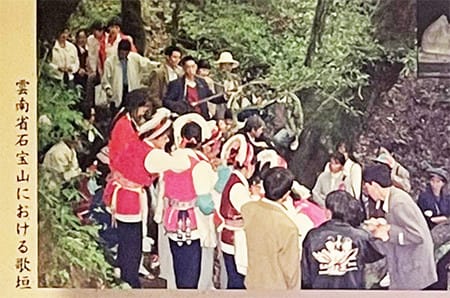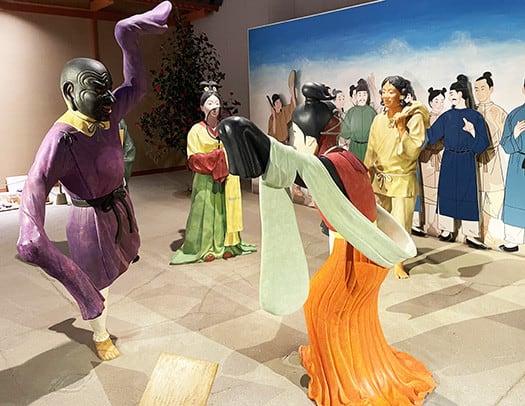



歌垣というのは人間の本然・種の保全本能に基づく男女の出会いの場。
そこには当然ながら普遍的な人間模様が表現される。
人類はながい歴史を刻む中で出会いの機会を文化として創造してきた。
万葉集はそういう「歌」文化を基盤として成立したとされる。
歌はもともと声に出して節を付けてうたうものとされる。
相聞という形式には始原的な告白要素がある。
「はないちもんめ」ではズバリ「◎◎ちゃんが欲しい」という告白が
お互い集団で囃しあうリズムと声出しの声援の中で
モジモジせずに自分の気持ちを正直に出してうたう、という形式文化。
ふだんは正直に自分の気持ちを表せない人間でも、
ああいった形式の中ではごく自然に表出させられる。
「どうせ、はないちもんめなんだから、思い切って・・・」
人間社会が考えた子孫繁栄維持のたぐいまれな知恵なのだろうと思う。
口に出して言って見ると相手の表情がそのときクローズアップされて
「あ、まんざらでも無いのか、やった!」という展開(笑)。
さまざまな楽器の演奏というのも、その雰囲気作りだともいえる。
万葉集という「歌」の基本はこうした相聞文化。
それが日本語コミュニケーション形式では五・七・五という
リズム感が自然と規範化されていったのだろうけれど、
文字化される前からも、こういう韻や「リズム感」は重要だったのだろう。
日本人の心理の奥底に強く訴えかけるものがあるのに違いない。
ながく社会として隣国関係である、
中国雲南省石宝山にも結婚相手を求める現系的な歌垣が残っている。
男女が数時間にわたって情熱的な即興の歌を交わし合う。
中国貴州省トン族には、最初はなぞなぞ問答のような歌の掛け合いで
相手の人格や知識などを判断し、やがて意中の人が決まると
「誓い」の歌となるという習俗文化がある。
一方、こうした歌垣の場で「芸能」が始原していったとされる。
歌垣は「都市」の原型とも言える人間交流の場となっていったが、
その発達とともに芸能も多様化し、洗練されて高度な技芸をもった
専門「芸能人」を生んでいくことになった。
万葉集巻十六に残された歌には、神事芸能としての「鹿踊り」に関する歌や
カニや鹿の様態を模した所作を伴って祝言を述べた芸能の歌がみられる。
日本列島社会古来の芸能に加えて半島や大陸での芸能も伝承した。
3番目の写真は奈良の大仏開眼供養でも行われたとされる
中国の呉の国の「伎楽」の様子を表している万葉文化館での展示。
エンターテイメントとしての人間社会文化の飛鳥・万葉の時代の実相。
やがて日本では飛鳥から奈良にむかって
本格的な「都市形成」が進展していくことになる。
いかにも日本人のまほろばを感じさせられる。・・・
English version⬇
[Utagaki and Performing Arts, Male-Female Love Culture Asuka Historical Testimony-7
◎◎-chan wanting "Hanaichimonme" collective hearing and confession. This is a human culture that is all about the survival of offspring. The origin of the entertainment that accompanies it. ...
Utagaki is a place where men and women meet based on human nature and the instinct to preserve the species.
Naturally, it is a place where universal human patterns are expressed.
Throughout our long history, human beings have created opportunities for encounters as part of their culture.
The Manyoshu is said to have been founded on the basis of such "song" culture.
Songs were originally meant to be sung aloud and accompanied by a verse.
The form of "aibun" has the element of primitive confession.
In "Hanaichimonme," the confession, "I want ◎◎chan," is sung to the rhythm of the group's musical accompaniment.
In the rhythm of the group's musical accompaniment and the cheering of their voices
The formal culture of the song is to express one's feelings honestly and without hesitation.
Even people who normally cannot express their feelings honestly
In such a formality, people who normally cannot express their feelings honestly are able to do so naturally.
In this way, the song is a formality that allows people who normally cannot express their feelings honestly to do so.
I think this is a unique wisdom of human society to maintain the prosperity of offspring.
When you say it out loud, the expression on the other person's face comes into focus, and you can see that he or she is not surprised.
"Oh, so they're not satisfied, huh? (laughs).
The playing of various musical instruments can also be said to create such an atmosphere.
The basis of the poetry of the Manyoshu is the culture of "sōmon," or "hearing and hearing again.
In the Japanese communicative form, the rhythm of the five-seven-five syllable form was naturally normative.
The rhythm of the five-seven-five syllables is a natural norm in the Japanese communication system, but even before it was written down, it was still used to create a certain atmosphere.
Even before the Japanese language was written, this sense of rhyme and rhythm must have been important.
It must have had a strong appeal deep in the psyche of the Japanese people.
The Japanese have long been neighboring societies.
In Shihbaoshan, Yunnan Province, China, there are still songagaki, a traditional form of seeking a marriage partner.
Men and women exchange passionate impromptu songs for several hours.
The Tong people of Guizhou Province, China, use a riddle-like singing contest to determine the personality and knowledge of the other person.
The Tong people of Guizhou Province, China, have a tradition of singing songs that at first resemble riddles to determine the personality and knowledge of the other person.
When the person they are interested in is decided, they sing a song of oath.
It is said that the "performing arts" originated at these "utagaki" gatherings.
Utagaki became the prototype of the "city" as a place for human interaction.
As the performing arts developed, they diversified and became more sophisticated, giving rise to specialized "entertainers" with advanced skills and techniques.
The development of the performing arts also gave birth to specialized "entertainers" with sophisticated and advanced skills.
In the poetry preserved in the Manyoshu (Anthology of Myriad Leaves), scroll 16, there is a song about the "Deer Dance" as a Shinto ritual art, as well as a song that describes the appearance of crabs and deer.
In addition to the ancient performing arts of the Japanese archipelago, there are also songs about the celebration of festivals accompanied by gestures that imitate crabs and deer.
In addition to the ancient performing arts of the societies of the Japanese archipelago, the performing arts of the peninsula and the continent were also handed down.
The third photo shows a performance of the "Gigaku" from the Wu Dynasty in China, which is said to have been performed at the opening ceremony of the Great Buddha in Nara.
This exhibit at the Manyo Culture Museum shows "Gigaku" from the Chinese province of Wu.
The reality of the Asuka and Manyo periods of human social culture as entertainment.
In Japan, the "city formation" progressed in earnest from Asuka to Nara.
The "city formation" progressed in earnest from Asuka to Nara.
This is a very Japanese Mahoroba. ...



















